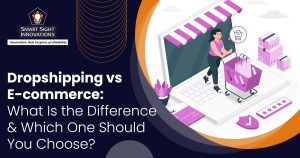 E-commerce and dropshipping are two popular business models for selling products online, but they operate quite differently. E-commerce involves stocking, storing, and shipping inventory yourself, while dropshipping leverages third-party suppliers to handle logistics.
E-commerce and dropshipping are two popular business models for selling products online, but they operate quite differently. E-commerce involves stocking, storing, and shipping inventory yourself, while dropshipping leverages third-party suppliers to handle logistics.
As an entrepreneur, choosing the right model impacts everything from startup costs and profit margins to operational complexity. This article explores the key distinctions between dropshipping and traditional e-commerce, examining the pros and cons of each approach.
We’ll provide insights to help you determine which model aligns best with your goals, resources, and appetite for risk when starting an online business.
Similarities and Differences Between Between E-Commerce and Dropshipping
Some of the similarities between e-commerce and dropshipping are:
1. Online Transactions
Both e-commerce and dropshipping involve conducting business transactions online, leveraging digital platforms and technologies to facilitate buying and selling of goods or services.
2. Digital Storefronts
Both e-commerce and dropshipping typically rely on digital storefronts, such as websites or mobile apps, where customers can browse products, place orders, and make purchases.
3. Customer Convenience
Both models offer convenience to customers by allowing them to shop from the comfort of their homes or on the go, anytime and anywhere with an internet connection.
4. Payment Processing
E-commerce and dropshipping both involve processing payments securely using various payment gateways and methods, ensuring the confidentiality and security of financial transactions.
5. Customer Service
Both the models provide responsive customer service to address inquiries, resolve issues, and ensure customer satisfaction throughout the purchasing process.
Some of the differences between e-commerce and dropshipping are:
1. Inventory Management
- E-commerce
Retailers purchase and manage inventory, storing products in warehouses or fulfillment centers.
- Dropshipping
Retailers do not hold inventory; products are shipped directly from suppliers to customers, and inventory management is handled by suppliers.
2. Initial Investment
- E-commerce
Requires higher initial investment for inventory, storage space, and fulfillment infrastructure.
- Dropshipping
Since there is no requirement to buy merchandise up front, the initial expenditure required is lower.
3. Control
- E-commerce
Retailers have full control over inventory, shipping, and quality control.
- Dropshipping
Retailers have limited control over shipping times, product quality, and inventory management, as these aspects are handled by suppliers.
4. Scalability
- E-commerce
Scaling may be limited by inventory and logistics constraints.
- Dropshipping
Highly scalable; can quickly add new products and suppliers without constraints.
5. Risk
- E-commerce
Higher risk due to inventory investment, potential overstocking, and logistics challenges.
- Dropshipping
Lower risk as no inventory investment is required, purchases made after sales are secured, and inventory management is outsourced to suppliers.
6. Flexibility
- E-commerce
Limited flexibility due to inventory management requirements.
- Dropshipping
More flexibility to experiment with products and suppliers, allowing for quick adaptation to market trends.
While both e-commerce and dropshipping involve online transactions and digital storefronts, they differ in terms of inventory management, initial investment, control, scalability, risk, and flexibility. Businesses can evaluate these factors to determine which model best aligns with their goals and resources.
When To Choose an E-Commerce Model?
Choosing a traditional e-commerce model depends on various factors such as business goals, resources, and market dynamics. Here are some scenarios when choosing this model might be appropriate:
1. Full Control Over Inventory and Operations
If you prefer to have full control over your inventory, shipping processes, and customer experience, traditional e-commerce might be the right choice. This model allows you to manage your inventory, quality control, branding, and logistics in-house, giving you more control over every aspect of your business.
2. Highly Customized Products or Branding
If your products require customization or branding that’s difficult to achieve through third-party suppliers, traditional e-commerce allows you to maintain full control over these aspects. You can ensure consistency in product quality, packaging, and branding to create a unique and memorable customer experience.
3. Existing Infrastructure and Resources
If you already have the infrastructure, resources, and expertise to manage inventory, fulfillment, and logistics in-house, traditional e-commerce may be a suitable option. Leveraging your existing capabilities can help streamline operations and maximize efficiency.
4. Established Supplier Relationships
If you have established relationships with reliable suppliers or manufacturers who offer competitive pricing and quality products, traditional e-commerce allows you to leverage these relationships to your advantage. You can negotiate favorable terms and ensure product availability and consistency.
5. Higher Profit Margins
If you’re looking to maximize profit margins and have the capacity to invest in inventory upfront, traditional e-commerce might be more profitable in the long run. By purchasing products at wholesale prices and selling them at retail prices, you can capture a larger share of the revenue per sale.
6. Specialized or Niche Products
If you offer specialized or niche products that require specific handling, packaging, or quality control measures, traditional e-commerce gives you more control over these aspects. You can ensure that your products meet the unique needs and preferences of your target market.
7. Long-Term Growth and Sustainability
If you’re planning for long-term growth and sustainability, traditional e-commerce allows you to build a solid foundation for your business by investing in infrastructure, brand development, and customer relationships. While it may require more upfront investment and effort, it can pay off in the form of greater control, stability, and profitability over time.
Ultimately, the decision to choose an e-commerce fulfillment model depends on your specific circumstances, goals, and preferences. Through meticulous analysis and taking into account variables like control, scalability, profitability, and resource distribution, you can select the fulfillment model that most closely matches your business goals and positions you for success.
When To Choose a Dropshipping Model?
Choosing a dropshipping model can be advantageous in certain situations, especially for entrepreneurs and businesses with specific needs and objectives. Here are some scenarios when choosing a dropshipping model might be appropriate:
1. Limited Capital Investment
Dropshipping can be a suitable alternative if you have limited funds or resources to invest up front in goods, storage space, and delivery infrastructure. Since you don’t need to purchase inventory in advance, dropshipping allows you to start an online store with minimal financial investment.
2. Low Risk and Reduced Financial Exposure
Dropshipping minimizes the risk associated with inventory investment and overstocking. Since you only purchase products after they’ve been sold and paid for by customers, you’re not left with unsold inventory that ties up capital or incurs storage costs.
3. Flexibility and Scalability
Dropshipping offers flexibility and scalability, allowing you to easily add new products, test different niches, and expand your product catalog without the constraints of inventory management. This agility makes it easier to adapt to changing market trends and customer preferences.
4. Location Independence and Remote Work
If you value location independence and the ability to work remotely, dropshipping enables you to operate your business from anywhere with an internet connection. You’re not tied to a physical location or warehouse, allowing for greater flexibility and freedom.
5. Focus on Marketing and Customer Experience
With inventory management outsourced to suppliers, dropshipping allows you to focus on marketing, sales, and customer service efforts. You can allocate more time and resources to building your brand, driving traffic to your website, and enhancing the customer experience.
6. Testing New Products or Markets
Dropshipping provides an opportunity to test new products or enter new markets with minimal risk. Since you can quickly add or remove products from your store without inventory constraints, you can experiment with different product categories and niche markets to identify profitable opportunities.
7. Low Overhead Costs
Dropshipping typically involves lower overhead costs compared to traditional e-commerce models. Without the need for warehousing, inventory management, or fulfillment infrastructure, you can save on expenses such as rent, utilities, and staffing.
Overall, choosing a dropshipping model can be beneficial for entrepreneurs and businesses seeking low-risk, flexible, and scalable e-commerce solutions. By leveraging the advantages of dropshipping, you can start and grow an online store with minimal investment and maximum efficiency, positioning yourself for success in the competitive e-commerce landscape.













